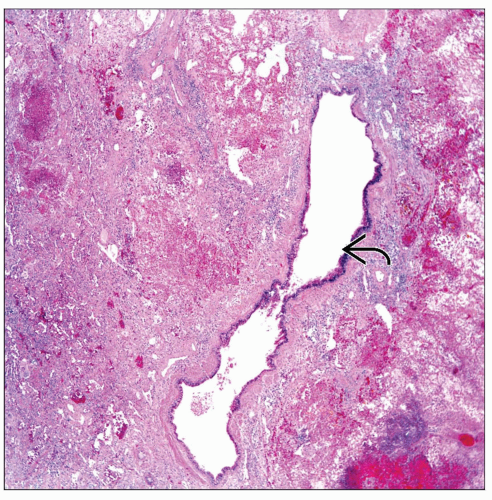Allergic Angiitis and Granulomatosis (Churg-Strauss)
Key Facts
Terminology
Systemic process characterized by presence of vasculitis, blood eosinophilia, and asthma
Etiology/Pathogenesis
No definitive etiology has been defined for Churg-Strauss syndrome
Probably an autoimmune process
Clinical Issues
Incidence
More common in adults
Since this process is systemic, it may involve different systems, including
Respiratory
Cardiovascular
Gastrointestinal
Renal
Central nervous
Skin
Laboratory findings
Blood eosinophilia
p-ANCA commonly positive although c-ANCA may also be positive in some cases
Treatment
Different therapeutic approaches have been tried depending on particular case
Prognosis
Majority of patients respond to treatment with steroids
Churg-Strauss syndrome may follow rapid and severe course unresponsive to treatment
TERMINOLOGY
Abbreviations
Allergic angiitis and granulomatosis (AAG)
Synonyms
Churg-Strauss syndrome
Definitions
Systemic process characterized by presence of vasculitis, blood eosinophilia, and asthma
ETIOLOGY/PATHOGENESIS
Etiology
No definitive etiology has been defined for Churg-Strauss syndrome
Probably an autoimmune process
CLINICAL ISSUES
Epidemiology
Incidence
No clear population study has been performed to evaluate exact incidence of this syndrome
It is believed that 10% of patients with well-defined vasculitides may belong to Churg-Strauss syndrome
Age
More common in adults
May vary from 3rd to 6th decade of life
Gender
No apparent gender predilection for Churg-Strauss syndrome
Ethnicity
No apparent predilection
Site
Since this process is systemic, it may involve different systems, including
Respiratory system
Cardiovascular
Gastrointestinal
Renal
Central nervous system
Skin
Presentation
Rhinitis
Asthma
Cough
Dyspnea
Erythema
Arthralgias
Myalgia
Neuropathy
Laboratory Tests
Blood eosinophilia
p-ANCA commonly positive although c-ANCA may also be positive in some cases
Elevation of erythrosedimentation rate
Elevated IgE levels
Leukocytosis
Hypergammaglobulinemia








